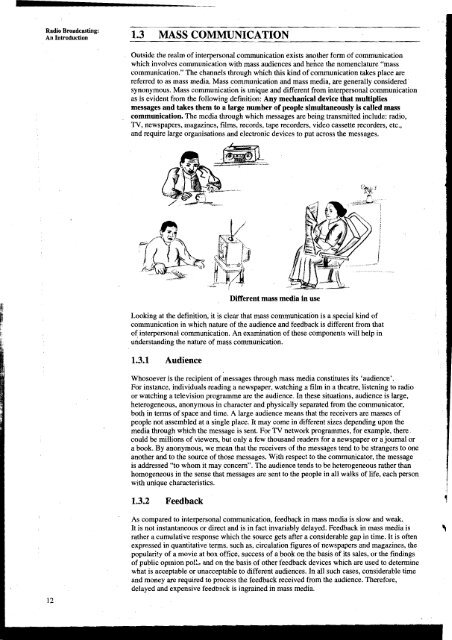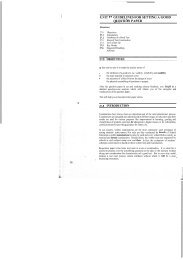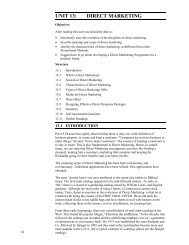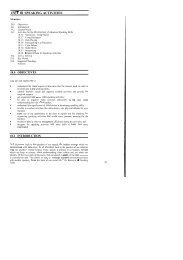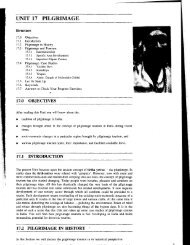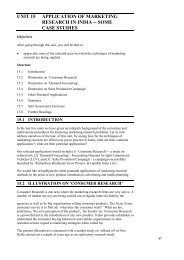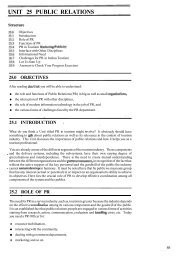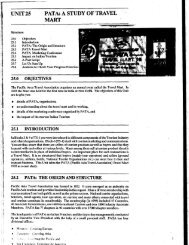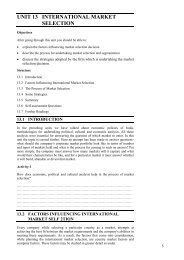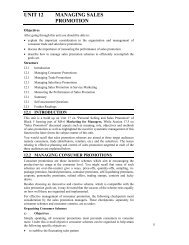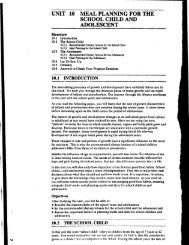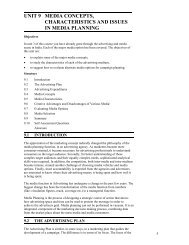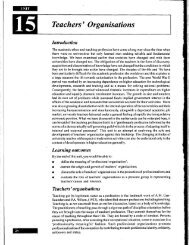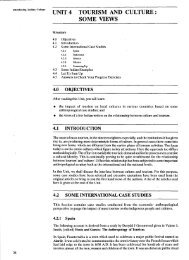UNIT 1 RADIO: A MEDIUM OF MASS COMMUNICATION - eGyanKosh
UNIT 1 RADIO: A MEDIUM OF MASS COMMUNICATION - eGyanKosh
UNIT 1 RADIO: A MEDIUM OF MASS COMMUNICATION - eGyanKosh
Create successful ePaper yourself
Turn your PDF publications into a flip-book with our unique Google optimized e-Paper software.
Radio Broadcasting:<br />
An Introduction 1.3 <strong>MASS</strong> <strong>COMMUNICATION</strong><br />
Outside the realm of interpersonal communication exists another form of communication<br />
which involves communication with mass audiences and hehce the nomenclature "mass<br />
communication." The channels through which this kind of communication takes place are<br />
referred to as mass media. Mass communication and mass media, are generally considered<br />
synonymous. Mass communication is unique and different from interpersonal communication<br />
as is evident from the following definition: Any mechanical device that multiplies<br />
messages and takes them to a large number of people simultaneously is called mass<br />
communication. The media through which messages are being transmitted include: radio,<br />
TV, newspapers, magazines, films, records, tape recorders, video cassette recorders, etc.,<br />
and require large organisations and electronic devices to put across the messages.<br />
Different mass media in use<br />
Looking at the definition, it is clear that mass communication is a special kind of<br />
communication in which nature of the audience and feedback is different from that<br />
of interpersonal communication. An examination of these components will help in<br />
uhderstanding the name of mass communication.<br />
1.3.1 Audience<br />
Whosoever is the recipient of messages through mass media constitutes its 'audience'.<br />
For instance, individuals reading a newspaper, watching a film in a theatre, listening to radio<br />
or watching a television programme are the audience. In these situations, audience is large,<br />
heterogeneous, anonymous in character and physically separated from the communicator,<br />
both in terms of space and time. A large audience means that the receivers are masses of<br />
people not assembled at a single place. It may come in different sizes depending upon the<br />
media through which the message is sent. For TV network programmes, for example, there<br />
could be millions of viewers, but only a few thousand readers for a newspaper or a journal or<br />
a book. By anonymous, we mean that the receivers of the messages tend to be strangers to one<br />
another and to the source of those messages. With respect to the communicator, the message<br />
is addressed "to whom it may concern". The audience tends to be heterogeneous rather than<br />
homogeneous in the sense that messages are sent to the people in all walks of life, each person<br />
with unique characteristics.<br />
1.3.2 Feedback<br />
As compared to interpersonal communication, feedback in mass media is slow and weak.<br />
It is not instantaneous or direct and is in fact invariably delayed. Feedback in mass media is<br />
rather a cumulative response which the source gets after a considerable gap in time. It is often<br />
expressed in quantitative terms, such as, circulation figures of newspapers and magazines, the<br />
popularity of a movie at box office, success of a book on the basis of its sales, or the findings<br />
of public opinion po!:, and on the basis of other feedback devices which are used to determine<br />
what is acceptable or unacceptable to different audiences. In all such cases, considerable time<br />
and money are required to process the feedback received from the audience. Therefore,<br />
delayed and expensive feedbzck is ingrained in mass media.


